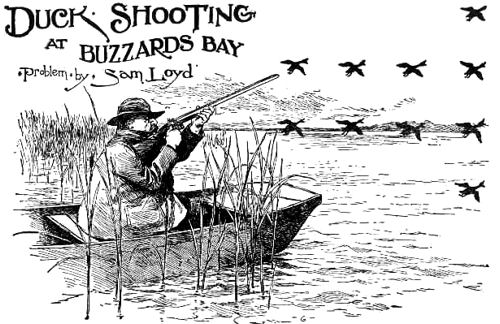



THE SUBJECT OF this puzzle inspiration is a familiar one to residents of the vicinity of Buzzard's Bay and introduces one of the many problems which, aside from the mere question of a hunter's luck, have doubtless been noticed by such as revel in the pleasures of duck shooting.
Next to shooting the chutes, there is no salt water sport so exhilarating as gunning for ducks, and there are few problems of a political or economical character which call for such profound statesmanship and administrative ability to show a balance sheet in favor of the internal receipts of the game bag, as against the expenditure of powder and shot, to say nothing of the other lavish expenditures which pertain to the make-up or a great duck hunter.
There are a thousand and one problems connected with the game, any one of which would be worthy of consideration, but with which our puzzlists are doubtless more familiar than myself, so I only refer to one little proposition which may be peculiarly characteristic of my style of duck shooting. Of course it is a great feat to get more than one duck at a single shot, and us that can only be done by getting several of them in a line, it set me to studying the principle upon which Buzzard Bay ducks line up, and I may have hit upon something which my uniform lack of skill as a marksman enabled me to discover.
I noticed that the birds invariably approached in two rows, with a corporal bird, so to speak, on each side in charge of either line, so that, as shown in the sketch, one could figure out three lines of four-in-row. Now just as soon as I got a line on four of these birds I would blaze away in the hopes of getting several birds with one shot. I could readily have killed one bird or possibly two. But my ambition to get four or none led to the result of my making the following interesting discovery. As soon as the smoke cleared away, so that I could open my eyes, I would find that the ten birds had reversed their direction, and were shooting away like a company of Filipinos, to reorganize somewhere back in the swamps. What I particularly noticed. However, was that while they came in the three lines of four-in-a-row form as shown, they invariably scooted away in the shape of five rows, with four-in-a-row. Just how they made the change I never could see. On account of the smoke and confusion, but I noticed that the fewest possible number of birds had changed their positions, so it will afford me special pleasure to give credit to any lucky duck who will solve this little problem for me correctly.
The picture shows ten ducks advancing in geometrical form, showing three rows of four-in-line. Now reorganize them so there will be five rows of four-in-line, simply by changing the position of the fewest possible number of ducks and it will incidentally show how many ducks Grover bags out of the flock.
The problem can be worked out practically by placing very small counters upon the ducks in the picture and move them around until you get live rows of four-in-a-row.
Duck shooting at buzzard's Bay is solved by changing the position of two ducks, as shown, which gives five rows of four-in-line and places one duck in Grover’s game bag:

2. A Tricky Problem.
Ask your friends if they can write down five odd figures to add up and make fourteen.
It is really astonishing how engrossed most people will get. and how much time they will spend over this, at first sight, simple problem. The questioner, however, must be careful to say figures, not numbers.
Here is the answer:
11
1
1
1
--
14
[Page 38]